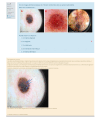Training Family Medicine Residents in Dermoscopy Using an e-Learning Course: Pilot Interventional Study
- PMID: 38739910
- PMCID: PMC11130775
- DOI: 10.2196/56005
Training Family Medicine Residents in Dermoscopy Using an e-Learning Course: Pilot Interventional Study
Abstract
Background: Skin cancers are the most common group of cancers diagnosed worldwide. Aging and sun exposure increase their risk. The decline in the number of dermatologists is pushing the issue of dermatological screening back onto family doctors. Dermoscopy is an easy-to-use tool that increases the sensitivity of melanoma diagnosis by 60% to 90%, but its use is limited due to lack of training. The characteristics of "ideal" dermoscopy training have yet to be established. We created a Moodle (Moodle HQ)-based e-learning course to train family medicine residents in dermoscopy.
Objective: This study aimed to evaluate the evolution of dermoscopy knowledge among family doctors immediately and 1 and 3 months after e-learning training.
Methods: We conducted a prospective interventional study between April and November 2020 to evaluate an educational program intended for family medicine residents at the University of Montpellier-Nîmes, France. They were asked to complete an e-learning course consisting of 2 modules, with an assessment quiz repeated at 1 (M1) and 3 months (M3). The course was based on a 2-step algorithm, a method of dermoscopic analysis of pigmented skin lesions that is internationally accepted. The objectives of modules 1 and 2 were to differentiate melanocytic lesions from nonmelanocytic lesions and to precisely identify skin lesions by looking for dermoscopic morphological criteria specific to each lesion. Each module consisted of 15 questions with immediate feedback after each question.
Results: In total, 134 residents were included, and 66.4% (n=89) and 47% (n=63) of trainees fully participated in the evaluation of module 1 and module 2, respectively. This study showed a significant score improvement 3 months after the training course in 92.1% (n=82) of participants for module 1 and 87.3% (n=55) of participants for module 2 (P<.001). The majority of the participants expressed satisfaction (n=48, 90.6%) with the training course, and 96.3% (n=51) planned to use a dermatoscope in their future practice. Regarding final scores, the only variable that was statistically significant was the resident's initial scores (P=.003) for module 1. No measured variable was found to be associated with retention (midtraining or final evaluation) for module 2. Residents who had completed at least 1 dermatology rotation during medical school had significantly higher initial scores in module 1 at M0 (P=.03). Residents who reported having completed at least 1 dermatology rotation during their family medicine training had a statistically significant higher score at M1 for module 1 and M3 for module 2 (P=.01 and P=.001).
Conclusions: The integration of an e-learning training course in dermoscopy into the curriculum of FM residents results in a significant improvement in their diagnosis skills and meets their expectations. Developing a program combining an e-learning course and face-to-face training for residents is likely to result in more frequent and effective dermoscopy use by family doctors.
Keywords: GP; dermatological; dermatology; dermatoscope; dermatoscopes; dermoscopy; e-learning; eLearning; education; family medicine; family physician; family physicians; family practitioner; family practitioners; general practice; intern; interns; internship; internship and residency; internships; primary health care; residency; resident; skin; training.
©Pauline Friche, Lionel Moulis, Aurélie Du Thanh, Olivier Dereure, Claire Duflos, Francois Carbonnel. Originally published in JMIR Formative Research (https://formative.jmir.org), 13.05.2024.
Conflict of interest statement
Conflicts of Interest: None declared.
Figures
Similar articles
-
Smartphone wallpapers for dermoscopy training in medical students and residents.Int J Dermatol. 2019 Mar;58(3):345-349. doi: 10.1111/ijd.14338. Epub 2019 Jan 17. Int J Dermatol. 2019. PMID: 30656675
-
The Prevalence of Dermoscopy Use Among Dermatology Residents in Riyadh, Saudi Arabia: Cross-Sectional Study.JMIR Dermatol. 2025 Jan 23;8:e63861. doi: 10.2196/63861. JMIR Dermatol. 2025. PMID: 39846892 Free PMC article.
-
A Novel Module Based Method of Teaching Electrocardiogram Interpretation for Emergency Medicine Residents.J Educ Teach Emerg Med. 2022 Oct 15;7(4):SG15-SG60. doi: 10.21980/J8Z06J. eCollection 2022 Oct. J Educ Teach Emerg Med. 2022. PMID: 37465135 Free PMC article.
-
Dermoscopy for the family physician.Am Fam Physician. 2013 Oct 1;88(7):441-50. Am Fam Physician. 2013. PMID: 24134084 Review.
-
Role of In Vivo Reflectance Confocal Microscopy in the Analysis of Melanocytic Lesions.Acta Dermatovenerol Croat. 2018 Apr;26(1):64-67. Acta Dermatovenerol Croat. 2018. PMID: 29782304 Review.
Cited by
-
Improving Melanoma Screening in Primary Care: The Experience of the Association of French General Practitioners Practicing Dermoscopy.Dermatol Pract Concept. 2025 Jul 31;15(3):6122. doi: 10.5826/dpc.1503a6122. Dermatol Pract Concept. 2025. PMID: 40790402 Free PMC article.
References
-
- Arnold M, Singh D, Laversanne M, Vignat J, Vaccarella S, Meheus F, Cust AE, de Vries E, Whiteman DC, Bray F. Global burden of cutaneous melanoma in 2020 and projections to 2040. JAMA Dermatol. 2022;158(5):495–503. doi: 10.1001/jamadermatol.2022.0160. https://europepmc.org/abstract/MED/35353115 2790344 - DOI - PMC - PubMed
-
- Koczkodaj P, Sulkowska U, Didkowska J, Rutkowski P, Mańczuk M. Melanoma mortality trends in 28 European countries: a retrospective analysis for the years 1960-2020. Cancers (Basel) 2023;15(5):1514. doi: 10.3390/cancers15051514. https://www.mdpi.com/resolver?pii=cancers15051514 cancers15051514 - DOI - PMC - PubMed
-
- Dinnes J, Deeks JJ, Chuchu N, di Ruffano LF, Matin RN, Thomson DR, Wong KY, Aldridge RB, Abbott R, Fawzy M, Bayliss SE, Grainge MJ, Takwoingi Y, Davenport C, Godfrey K, Walter FM, Williams HC. Dermoscopy, with and without visual inspection, for diagnosing melanoma in adults. Cochrane Database Syst Rev. 2018;12(12):CD011902. doi: 10.1002/14651858.CD011902.pub2. https://europepmc.org/abstract/MED/30521682 - DOI - PMC - PubMed
-
- Argenziano G, Fabbrocini G, Carli P, De Giorgi V, Sammarco E, Delfino M. Epiluminescence microscopy for the diagnosis of doubtful melanocytic skin lesions. Comparison of the ABCD rule of dermatoscopy and a new 7-point checklist based on pattern analysis. Arch Dermatol. 1998;134(12):1563–1570. doi: 10.1001/archderm.134.12.1563. https://jamanetwork.com/journals/jamadermatology/fullarticle/189703 - DOI - PubMed
-
- Approche territoriale des spécialités médicales et chirurgicales. Situation au premier janvier 2023 [Territorial approach to medical and surgical specialties. Situation on 1 January 2023] Conseil national de l'Ordre des médecins [French National Medical Council] [2024-02-05]. https://www.conseil-national.medecin.fr/sites/default/files/external-pac... .
LinkOut - more resources
Full Text Sources
Miscellaneous





